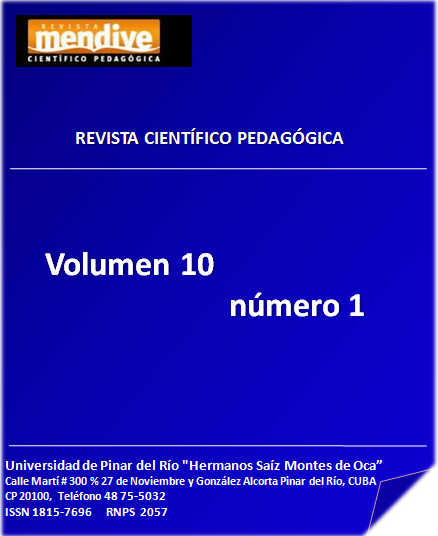Understanding mathematical and physical concepts: a diagnostic study in Latin American universities students
Main Article Content
Abstract
Downloads
Article Details
References
ACEVEDO, J.A. (1989). Comprensión newtoniana de la caída de los cuerpos. Un estudio de su evolución en el Bachillerato. Enseñanza de las Ciencias 7 (3), pp. 241-246.
BLISS, J., MORRISON, I. y OGBORN, J. (1988). A longitudinal study of dynamics concepts. International Journal of Science Education, 10 (1), pp. 99-110.
BLOOM, B. (1972). Taxonomía de las Metas Educativas. Tomo I: Ámbito del Conocimiento. Alcoy: Marfil
BURNS, J.C., OKAY, J.R. & WISE, K.C. (1985). Development o an Integrated Process Skill Test: TIPS II. J.R.S.T. 22 (2), pp. 169-177.
CARRASCOSA, J. (1987). Tratamiento didáctico en la enseñanza de las Ciencias, de los errores conceptuales. Tesis doctoral, Universidad de Valencia.
CLEMENT, J. (1982). Students’ preconceptions in introductory mechanics. American Journal of Physics, 50, pp. 66-71.
DILLASHAW, F.G. & OKAY, J.R. (1980). Test of the Integrated Science Process Skills. Science Education 64 (5), pp. 601-608.
of propositional logia and formal operacional chemata during the secondary school years. Journal of Research in Science Teaching 15 (6), 465-478.
MALONEY, D.P. (1984) Rule-governed approaches to physics Newton’s third law. Physics Education 19, 37-42.
MALONEY, D. P., O’KUMA, T. L., HIEGGELKE, C. J. y VAN HEUVELEN, A. (2001). Surveying Students' conceptual knowledge of electricity and magnetism. American Journal of Physics, 69(7), pp. S12-S23.
McDERMOTT, L.C. (1984). Research on conceptual understanding in mechanics. Physics Today 37, 24-32.
McDERMOTT, L.C. (1991). What we teach and what is learned – Closing the gap (Millikan Lecture 1990). American Journal of Physics 59 (4), 301-315.
NIEDA, J., CAÑAS, A. & MARTÍN-DÍAZ, M.J. (2004). Actividades para evaluar Ciencias en Secundaria. Madrid: A.Macha
OECD (2000). Measuring Student Knowledge and Skills: The PISA 2000 Assessment of Reading, Mathematical and Scientific Literacy. (Versión española, La medida de los conocimientos y destrezas de los alumnos. La evaluación de la lectura, las matemáticas y las ciencias en el Proyecto Pisa 2000, 2001. Madrid: MECD-INCE).
OECD (2001). Knowledge and Skills for Life. First Results from PISA 2000. Paris: OECD.
OECD (2003). Literacy Skills for the World of Tomorros. Further Results from PISA 2003. Paris: OECD
OSBORNE, R.J. y FREYBERG, P. (1985). Learning in Science. The implications of children’s Science. London: Heinemann, (El aprendizaje de las ciencias. Implicaciones de la ciencia de los alumnos, 1991. Madrid: Narcea).
PÌAGET, J. e INHELDER, B. (1969). The Psychology of the Child. New Cork: Basic Books.
PRO BUENO, A. de (1998). ¿Se pueden enseñar contenidos procedimentales en las clases de ciencias? Enseñanza de las Ciencias 16 (1), pp. 21-41.
SALINAS DE SANDOVAL, J., CUDMANI, L.C. de y PESA DE DANÓN, M. (1996) Modos espontáneos de razonar: un análisis de su incidencia sobre el aprendizaje del conocimiento físico a nivel universitario básico. Enseñanza de las Ciencias 14 (2), pp. 209-220.
TERRY, C. y JONES, G. (1986). Alternative frameworks: Newton’s third law and conceptual change. European Journal of science Education 8 (3), pp. 291-298.
TVERSKY, A., y KAHNEMAN, D. (1982). Availability: A heuristic for judging frequency and probability. En Kahneman, D., Slovic, P. Tversky, A. (Eds.). Judgement under uncertainty: Heuristics and biases (pp. 163-178). Cambridge: Cambridge University Press.
VIENNOT, l. (1979). Spontaneous reasoning in elementary dynamics. European Journal of science Education 1, pp. 205-221.
WANG, M.C., HAERTEL, G.D. y WALBERG, H.J. (1993). Toward a Knowledge Base for School Learning. Review of Educational Research 63, pp. 249-294.
WATTS, D. y ZYLBERSZTAJN, A. (1981). A survey of some children’s ideas about force. Physics Education, 16, pp.360-365.


